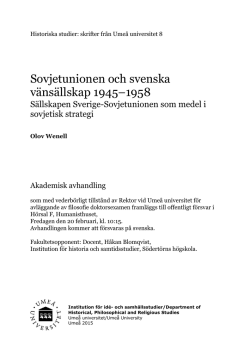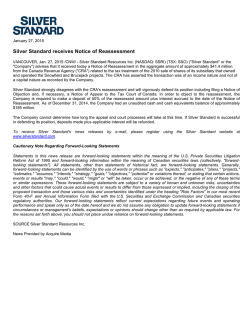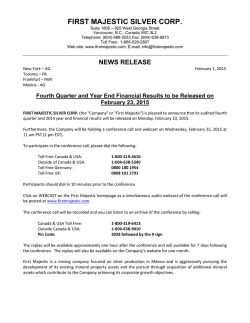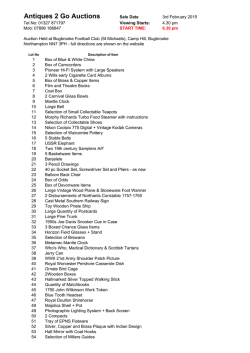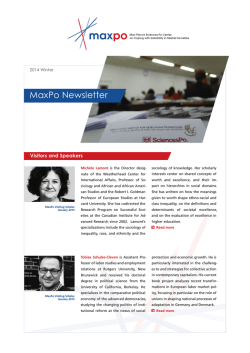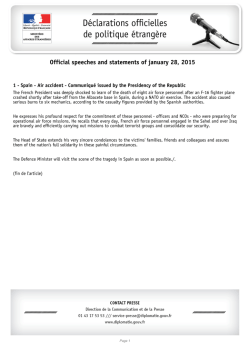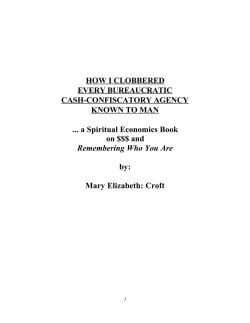
Critical Terms for Media Studies
15 : : E X C H A N G E We commonly speak of people “exchanging insults” or “exchanging addresses.” One can also speak of exchanges of letters, prisoners, ideas, or gunfire. These examples appear to have only one thing in common. They are all governed by a principle of reciprocity: there are two parties, each of whom gives and gets the same thing in roughly equal measure. Indeed, the primary definition for exchange in the Oxford English Dictionary is “the action, or an act, of reciprocal giving and receiving.” When we use the term in the abstract, however, we are usually talking about economic transactions, the kind regulated, for example, by the Securities and Exchange Commission. Here is the definition on one Wall Street Web page: Exchange: to provide goods and services and receive goods or services of approximately equal value in return; here, also called barter. We are speaking here of a voluntary transaction. Two parties each agree to transfer something in their possession to the other—presumably because at that moment what they are getting is worth more to them than what they are giving up. For economists, voluntary exchanges of this sort are the basic building blocks of any market system—which is why many see the market as the very incarnation of human freedom. In each of these examples whatever it is that passes back and forth can be referred to as the “medium” of the exchange. Economic transactions, however, are somewhat different than the others. Those who exchange greetings, or gunfire, are giving and taking more or less exactly the same kind of thing. But no one would normally exchange one tube of toothpaste for another tube of toothpaste. What would be the point? The point of economic exchange is to get one’s hands on something one does not already have. In fact, in a market economy, whether one is selling a house or buying a candy bar, most commodities are not exchanged for other commodities at all but for a symbolic substance, which may or may not take material form, referred to as money. Money is thus treated as the ultimate “medium of exchange,” a universal equivalent. In order to explain how this situation came about, economists like to tell a story. It goes back at least to Adam Smith and to this day can be found in just about any economic textbook. In primitive times, the story goes, people did indeed exchange things directly with one another. Say someone had a large number of chickens and wished to acquire a cow. He would seek out someone with an extra cow who needed chickens and strike a deal. Obviously this was not the most efficient way to go about things (what if he couldn’t find such a person?). So, the story continues, eventually people began to stockpile certain commodities that were in general demand—perhaps cows at first; later, gold and silver—and these came to be used as a medium of exchange. Once gold, say, came to be used this way, it also became an abstract measure of value—one could calculate the price of anything in gold—and provided a means to store up wealth. This was money. Gradually, governments began to issue pieces of gold and silver in uniform sizes, and one saw the emergence of complex systems of banking, credit, and, eventually, futures markets. At the same time, most economists (e.g., Samuelson ) insist that all of this is largely froth, that ultimately all economies are just elaborate systems of barter. We will examine these premises in a moment (they are almost entirely false). For now let me stress that, just as economists argue that all economic life is founded on barter, many social scientists have held that social life in general is founded on exchange. This position was particularly popular in the mid-twentieth century. In the s, for example, Claude Lévi-Strauss (, ) made a famous argument that not only was reciprocity the organizing principle of all social life, but that all societies could be said to be organized around three fundamental forms of exchange, each distinguished by its principle medium: • the economy (the exchange of goods), • kinship (the exchange of women), and • language (the exchange of words). While this was always considered an extreme position, it raises telling questions. Even if we put aside Lévi-Strauss’s notoriously controversial argument that society is founded on the incest taboo, whereby men “renounce their sisters to exchange them against the sisters of others,” in what way is trading fish for plantains, or buying an umbrella, really analogous to conducting a conversation? Are the participants in a conversation necessarily trying to acquire something—information, perhaps, or ideas? If so, in what way does the logic resemble that of a financial • transaction? One could make a case. Certain types of information, for example, might be considered scarce resources; one might not wish to give up a piece of such information except in exchange for another piece (or something else) that one considers to be of equal value. Ideas, on the other hand, often work on exactly the opposite principle: the more people know you have such a good idea, the greater its value. Or does “exchange” here simply refer to any sort of interaction conducted on a fairly equal basis? “Exchange theory” of this sort has largely faded away. More prevalent nowadays is what has come to be referred to as “rational choice theory,” an approach that takes the logic of the market—self-interested economic exchange—and applies it just about every human relation, even those that do not involve money or material goods. The emphasis here is not on reciprocity but on the fact that, in market transactions, each party is normally trying to gain an advantage over the other. The assumption, inspired by neoclassical economics, is that there are only so many good things in the world and all of us go about life calculating how we can get the most of them for the least effort or sacrifice; thus, when two people interact, one can expect that each will be calculating how to maximize his or her own advantage. In this sense, absolutely everything, from smiles and compliments to honor and faith can be considered, like so many cans of sardines or tractor-trailers, as media for an endless series of self-interested exchanges—this being the basic business of human life. The legacy of such theories makes it very difficult to talk about exchange in the abstract, since the subject quickly comes to encompass everything. What’s more, the ideology of exchange has become so central to our culture that an essay like this must always begin by puncturing assumptions. Let me do so. In reality, market exchange—or reciprocal exchange of any sort—cannot provide a model for all human activity. Outside of market contexts, moreover, valuable objects tend to become the media not of exchange, but of human relationships, which are often anything but reciprocal in nature. On the other hand, this means that they are extremely important; since human beings are, after all, largely the sum and internalization of their relationships with others, this makes such objects the material media through which we become who we are. The Myth of Barter and Varieties of Noncommercial Exchange Around a century ago anthropologists began to test economists’ assumptions by examining economic systems in Melanesia, Africa, Southeast Asia, and the Americas that operated without commercial markets. They Exchange • soon discovered the economists were simply wrong. They were unable to find a single society where economic life was based on barter of the “I’ll give you twenty chickens for that cow” variety. Where barter did occur, it occurred between societies: that is, between strangers who would just as happily have stolen the goods had it been more convenient. Transactions within societies, that is, between those to whom people felt any sort of moral commitment, tended to take a very different form. They more closely resembled the way people in our own societies act outside the impersonal sphere of the market, when dealing with family, lovers, friends, or enemies. What really mattered were the personal relationships. As a result, the last thing anyone was interested in was barter, a simple tit for tat that created no further mutual obligations. Even when people were mainly interested in the goods, they would pretend otherwise. Accounts were almost never kept, and insofar as there was overt competition, it was likely to take the form of people vying to outdo one another in grand shows of generosity. As a result, French anthropologist Marcel Mauss () dubbed these “gift economies.” This is a useful phrase, but it can be slightly deceptive. First of all, “gifts” of this sort have nothing to do with altruism or charity—concepts that really emerge only with the rise of the market, as its complementary mirror image. Rather, a gift economy is one in which wealth is the medium for defining and expressing human relationships (Gregory ). Second, people have an unfortunate tendency to talk about “the gift” as if it were just one thing, lumping together what are in fact a wide variety of different kinds of noncommercial transaction that operate according to very different principles. Here is a very simplified typology: I use “communistic” in the sense of relations that operate on Louis Blanc’s famous principle “from each according to his abilities, to each according to his needs.” While there has almost certainly never been a society in which everyone interacts on this basis in every context, there is in any social system always a certain baseline communism, at least for certain basic needs (e.g., one freely offers directions to strangers, assuming that any stranger would do likewise; and in some societies, no one would normally refuse a request for food) or in certain circumstances (such as dire emergencies). Sometimes communistic relations are institutionalized: two clans might each have responsibility for, say, burying the other’s dead. In such cases the responsibilities are rigorously specified, but no accounts are kept. In relations between very close kin, close friends, • “blood brothers,” and the like, the range of responsibilities can become so wide as to encompass almost anything; hence, Mauss suggested that most societies can be seen as threaded with relations of what he called “individualistic communism” (, ). Communistic relations are reciprocal only in the sense that both sides are equally disposed to help one another; there is no feeling that accounts ought to balance out at any given moment—in part, because there’s no assumption such relations will ever end. Here falls the exchange of compliments or favors or rounds of drinks. Such relationships can be broken off after any given round because the return is considered a more or less exact equivalent to the initial gift. Often relations are kept up by delaying the response in time (if I buy dinner for a friend, he will likely feel in my debt until he is able to reciprocate). Or people make a point of ensuring the response is not quite an equivalent (if he buys me a much more expensive dinner, or a much cheaper one, the feelings of debt do not quite cancel out). There are numerous variations here, ways of testing the limits. The critical thing is that unlike communistic relations, these are not assumed to be permanent. Reciprocity of this sort is about maintaining one’s personal autonomy in a relatively equal relationship. Relations between masters and slaves, patrons and clients, parents and children, and so on do not tend to operate in terms of reciprocity but rather by a logic of precedent. If one gives money to a beggar (or to a charity fund) the recipient will almost certainly not feel obliged to return something of equal value but instead will be more likely to ask for more. Similarly, if parents allow a child an indulgence the child is likely to expect the same in the future. The converse is equally true: if a medieval serf or vassal presented a gift to a feudal superior, it was likely to be treated as a precedent, added to the web of custom, and thus transformed into an obligation for the future. There are endless variations here too—from institutionalized plunder or ritualized theft to redistribution, inheritance, or other gifts that pass one’s superior status to former inferiors—but except for the last, all presume a permanent or at least ongoing relation that has nothing to do with reciprocal exchange because it is not assumed to have anything to do with equality. Exchange • Tit-for-tat exchange can also mount into contests of one-upmanship, where each party tries to present a gift or countergift so lavish that their rival cannot reciprocate. In these situations the equal standing of the parties is up for grabs at any moment, with the danger that the relation might degenerate at any moment—at least symbolically—into subordination and hierarchy. “Gifts make slaves,” the Inuit saying goes, “as whips make dogs.” This is the sort of gift exchange that has tended to attract the most attention in the literature on the subject, but it only really becomes a dominant social form in stateless aristocratic societies like Homeric Greece, Vedic India, early Celtic or Germanic societies, or the indigenous societies of the Pacific Northwest. + + + As should be clear, none of these modes are peculiar to “gift economies.” We are all communists with our closest friends and feudal lords when interacting with small children. What varies is how they knit together with the more impersonal relations of the market. It’s also clear that such transactions are by no means uniformly governed by principles of reciprocity: those involved in agonistic exchange do not wish the outcome to be reciprocal, and communistic and hierarchical relations are not really even forms of exchange. This is important because there is a widespread assumption that societies are, in some sense, systems of reciprocal exchange in which accounts ultimately balance out. This is simply not the case. In fact it is so obviously not the case that one might well ask why it is even possible to imagine such a thing. Probably the reason is that reciprocity seems, everywhere, essential to conceptions of justice; therefore, when attempting to describe extremely hierarchical systems in the abstract, people will fall back on lines like “this is how we repay our parents for having raised us” or “the peasants provide food and the lords provide protection”— even though the logic of practice is utterly different. The very idea of “the market,” in which all exchanges balance out, is just such an imaginary projection; it comes down to little more than the faith that ultimately, somehow, everything will always balance out. One could well argue that the very idea that we all live in bounded objects called “societies” (an idea that almost always dissolves away when you try to define its borders) is a similar imaginary totality. In almost all of these cases, the material medium of exchange can be said to take on some of the qualities of the relationship. Schieffelin (, ) provides a simple example: among the Kaluli in Papua New • Guinea, two friends who eat a bird together will henceforth refer to each other as “my bird.” This sort of thing is actually quite common in communistic relations. Hierarchical transactions tend to be more complicated. The Kwakiutl and other First Nations of the Northwest Coast of North America are famous for ceremonies called potlatches, communal feasts that aristocrats would sponsor in order to “fasten on” a title they had received. Such titles were embodied in material objects: masks and other regalia, ownership of which carried with it the rights to perform certain roles in dramatic rituals, to gather berries along a river, and so on. If the holder of such a title gave it, with its accompanying paraphernalia, to someone else, the recipient would become the person the giver used to be (much as if one granted title to a dukedom). In order to be recognized in that new title, however, the new holder was expected to appeal to his clan and allies to amass vast sums of wealth in blankets, bracelets, fish oil, and so on, in order to hold a potlatch in which he would shower this wealth on members of rival clans. These goods were, in turn, called “bad things,” since the point was to show how contemptuous the title holder was of such trifles, and handing them out was a way of belittling the recipients. Occasionally, when two aristocrats laid claim to the same title, one chief would actually destroy some object of great value, pass the remains to his rival, and challenge him to reciprocate. Almost always, in Kwakiutl exchange, the medium served to define the recipient—it ennobled or degraded. In other systems—say, a caste system where different orders of society are defined as “smiths” or “fishermen” on the basis of what products or services they provide to the king (Hocart )—the medium defines the giver. Always, though, it is human qualities that are at stake. On the Origins of Currency What, then, were the real origins of money? Many societies without commercial markets did have something that resembled money—what used to be referred to as “primitive currencies”: shell moneys, feather moneys, wampum, trade beads, whale’s teeth, and the like. In just about every case, they were used primarily not to acquire wealth but to rearrange relations among people. Tellingly, the objects themselves rarely consisted of what an economist would consider “useful commodities”— food, tools, or the like—but rather things that were otherwise used mainly as forms of personal adornment. Like gold and silver, beads, shell necklaces, and the like exist primarily to be seen, and in being seen, to establish the beauty, rank, or significance of the bearer. These are visual media, then, used to define the value of persons, that have become deExchange • tached, as it were, and serve as the media of exchange between them (Graeber ). The most common use of such currencies is for paying what anthropologists call “bridewealth”: a man’s parents will present them to the family that provides him with their daughter in marriage. Usually the payment establishes their rights to the woman’s fertility, that is, to claim the offspring of the union as members of their own lineage or clan. The French anthropologist Pierre Rospabé () makes a compelling argument that these are not even, strictly speaking, payments; most societies with bridewealth recognize that the only way to really reciprocate the gift of a sister in marriage is to give one’s own sister. In societies that do practice sister exchange, bridewealth is only presented when that option is not available or when the return is to be delayed to later generations. Similarly with the second most important use of primitive currencies, the payment of “bloodwealth,” or compensation for wrongful death, a taking rather than a giving of life. Material wealth cannot truly compensate for the death of a loved one, and no one pretends that it can. At best, it can be used to acquire a wife for one of the victim’s relatives (or even for his ghost), whose offspring will in some sense replace him. In either case, money originates as a token of recognition of a debt that cannot ever be repaid. How then can such a token become its opposite: a means of payment and medium of exchange—a way of canceling debts? There are a variety of possible explanations. Once such tokens exist, they tend to take on a kind of power in and of themselves. What begins as a pure medium of expression of the importance of certain social relations—particularly those of creating or destroying life—comes to be seen as possessing a vital power in and of itself, even as the origin of the very value it represents. Thus it becomes a way of creating new social relations. The Iroquois, for instance, never used wampum to buy or sell things to each other, but they did use it to create treaties and agreements. Often bloodwealth systems develop into elaborate systems of fines and penalties for all sorts of offenses; some (see, e.g., Grierson ) have suggested these might be the origins of “general purpose” currency. However this may be, the historical record makes one thing quite clear: wherever tokens that were once used mainly to regulate sexual or domestic affairs transform themselves into full-blown commodity money, allowing the definitive transfer or alienation of what is bought and sold, the result is a moral crisis. New and scandalous possibilities arise, such as commercial prostitution and slavery. This often sparks frantic efforts by the wealthy to insulate their own families from such possibilities and to relegate them exclusively to the poor. The results for the situation of women of all classes • are often devastating. To chose just two notorious examples: the Mediterranean “honor complex” with its sequestration of women appears to trace back to aristocratic reactions to the market in ancient Greece (e.g., Kurke ), and the practice of veiling in the Near East appears to have originated as a way of marking off “respectable” women from slaves and prostitutes, whose bodies could be bought and sold (Lerner ). A Very Brief History of the World in Terms of Media of Exchange Current research has revealed that the economists’ original assumptions—that first there was barter, then money, then finally complex systems of credit—gets the order precisely backward. Credit money came first. The earliest forms of money, in ancient Mesopotamia and Egypt, were, as we would now put it, virtual; banking, interest, and even the equivalent of expense accounts all existed long before the invention of actual coined money. For two thousand years, then, the “media of exchange” were records kept on cuneiform tablets. Conversely, genuine barter, when it does occur, seems to emerge—as quite recently in Russia and Argentina—in places where currency systems once existed but have (at least temporarily) broken down (Servet ). The story is too long to tell in any great detail but one might sketch an outline of Eurasian history along the following lines. (– ) : Our best information on the origins of money goes back to ancient Mesopotamia, but there seems no particular reason to believe matters were radically different in Pharaonic Egypt, Bronze Age China, or the Indus Valley. The economy was dominated by large public institutions (temples and palaces) whose bureaucratic administrators essentially created money of account by establishing a fixed equivalent between silver and the staple crop, barley. Debts were calculated in silver, but silver was rarely used in transactions; payments were instead made in barley or anything else that happened to be handy and acceptable. Major debts were recorded on cuneiform tablets kept as sureties by both parties to the transaction. Markets, certainly, did exist. Prices of certain commodities that were not produced within temple or palace holdings, and thus subject to administered price schedules, tended to fluctuate according to the vagaries of supply and demand. Even here, though, such evidence as we have (e.g., Hudson , ; , ) suggests that everyday purchases, such as Exchange • beer advanced by “ale women,” or local innkeepers, appear to have been on credit, with tabs accumulating to be paid, typically, at harvest time. Interest rates, fixed at percent, remained stable for two thousand years. This was not a sign of government control of the market; at this stage, such institutions were what made markets possible. Insofar as governments did intervene, it was to deal with the effects of debt. In bad years the poor tended to become hopelessly indebted to the rich and would often have to surrender their lands, and ultimately, family members, into debt peonage. Hence, it became customary for each new ruler to wipe the slate clean, cancel debts, and return bonded laborers to their families. ( – ) : This is the age that saw the emergence of coinage, as well as the birth, in China, India, and the Middle East, of all of the major world religions. It was a time of spectacular creativity and, in much of the world, almost equally spectacular violence, from the Warring States in China and fragmentation in India to the carnage and mass enslavement that accompanied the expansion (and later, the dissolution) of the Roman Empire. Coined money, the actual use of gold and silver as a medium of exchange, allowed markets in the now more familiar, impersonal sense of the term. Precious metals were also far more appropriate for an age of generalized warfare, for the obvious reason that they can be stolen. Coinage, certainly, was not invented to facilitate trade (the Phoenicians, the consummate traders of the ancient world, were among the last to adopt it). It appears to have first been invented to pay soldiers. Throughout antiquity one can continue to speak of what Ingham (, ) has dubbed the “military-coinage complex.” He might better have called it a “military-coinage-slavery complex,” since the diffusion of new military technologies (Greek hoplites, Roman legions) was closely tied to the capture and marketing of slaves. The other major source of slaves was debt; now that states no longer periodically wiped the slates clean, those not lucky enough to be citizens of the major military citystates were fair game. The credit systems of the Near East did not crumble under commercial competition; they were destroyed by Alexander’s armies—armies that required half a ton of silver bullion per day in wages. The tax systems of the Hellenistic and Roman empires, which demanded payment in coins the state itself had mined and minted, were designed to force their subjects to abandon other modes of circulation and enter into market relations, so that soldiers (and government officials) would be able to buy things with that money. The effects of the • constant wars conducted by those legions, in turn, guaranteed that much of the consequent trade was in fact in human beings, or in the products of slave labor. However tawdry the origins of coinage, the creation of new media of exchange appears to have had profound intellectual effects. Some (Shell , ; Seaford ) have even argued that early Greek philosophy became possible only because of conceptual innovations introduced by the technology of coinage. Certainly, it seems significant that the emergence of so many major philosophical trends and world religions coincided almost exactly with that of coined money. While the precise links are yet to be fully explored, one thing is clear. The ideals of charity, altruism, and selfless giving typically promoted within the new religions appear to have arisen in direct reaction to the logic of the market. As Mauss liked to point out, in a gift economy pure selfishness, or pure selflessness, would be almost inconceivable. To put the matter crudely: it would seem that, once a certain social space is dedicated simply to the selfish acquisition of material things, it becomes almost inevitable that another domain will be set aside to preach, from the perspective of ultimate values, the unimportance of material things and the illusory nature of selfishness—or even of the self. The fact that these markets were, in fact, based on coinage, which allowed for far more impersonal and, hence, potentially violent forms of market behavior than earlier credit relations presumably made the distinction all the more compelling. ( – ) - If the Axial Age saw the emergence of complementary ideals of egoism and altruism, commodity markets and universal world religions, the Middle Ages was the period in which those two institutions began to merge and monetary transactions increasingly came to be carried out through social networks defined and regulated by those same religions. This in turn occasioned a return, throughout the world, of various forms of virtual credit-money. In Europe, where all this took place under the aegis of Christendom, coinage was only sporadically, and unevenly, available. Prices after CE were calculated largely in terms of an old Carolingian currency that no longer existed (it was referred to even then as “imaginary money”), but day-to-day buying and selling was mainly carried out with tallysticks, notched pieces of wood that were broken in two as records of debt—one half being kept by the creditor, the other by the debtor. Such tally-sticks remained in common use in much of England well into the Exchange • sixteenth century (Innes , ). Larger transactions were handled through bills of exchange, with the great commercial fairs serving as clearinghouses. The church, meanwhile, provided a legal framework, enforcing strict controls on the lending of money at interest and prohibitions on debt bondage. The real nerve center of the medieval world economy, however, was the Indian Ocean, which along with the central Asian caravan routes, connected the great civilizations of India, China, and the Middle East. Here trade was conducted through the framework of Islam, which not only provided a legal structure highly conducive to mercantile activities (notwithstanding an absolute prohibition on the lending of money at interest) but allowed for peaceful relations between merchants over a remarkably large part of the globe, fostering the creation of a variety of sophisticated credit instruments. In China this same period saw the rapid spread of Buddhism, the invention of paper money, and the development of even more complex forms of credit and finance. Like the Axial Age, this period saw its share of carnage and plunder (particularly during the great nomadic invasions), and coinage remained an important medium of exchange in many times and places. Still, what really characterizes the Middle Ages appears to be a movement in the other direction. Money, during most of the medieval period, was largely delinked from coercive institutions. Money changers, one might say, were invited back into the temples, where they could be monitored. The result was a flowering of institutions premised on a much higher degree of social trust. (–) With the advent of the great European empires—Iberian, then North Atlantic—the world saw a reversion to the use of chattel slavery, plunder, and wars of destruction, and the consequent rapid return of gold and silver bullion as the main form of currency. Historical investigation will probably demonstrate that the origin of these transformations were more complicated than we ordinarily assume. Among the main factors prompting the movement back to bullion, for example, were popular movements during the early Ming dynasty, in the fifteenth and sixteenth centuries, that ultimately forced the Chinese government to abandon not only paper money but any attempt to impose its own currency. This led to a reversion in the vast Chinese market to an uncoined silver standard. Since taxes were also gradually commuted into silver, it soon became the more or less official Chinese policy to bring as much silver into • the country as possible, so as to keep taxes low and prevent new outbreaks of social unrest. This sudden enormous demand for silver had effects across the world. Most of the precious metals looted by the conquistadors, and later extracted by the Spanish from the mines of Mexico and Potosi (at almost unimaginable cost in human lives), ended up in China. These new global-scale connections have, of course, been documented in great detail. Crucial here is the delinking of money from religious institutions, and its relinking with coercive ones (especially the state), accompanied here by an ideological reversion to “metallism.” Credit, in this context, was increasingly an affair of states, which themselves ran largely by deficit financing, a form of credit that was, in turn, largely invented to finance increasingly expensive wars. Internationally, the British Empire was steadfast in maintaining the gold standard even through the nineteenth and early twentieth centuries. ( ) The current era might be said to have been initiated on August , , when President Richard Nixon officially suspended the convertibility of the U.S. dollar into gold and effectively created the present floating currency regimes (Gregory ). We have returned, then, to an age of virtual money, in which consumer purchases in wealthy countries rarely involve even paper money, and national economies are driven largely by consumer debt. All of this has been accompanied by what’s often called a “financialization” of capital, with speculation in currencies and financial instruments becoming a domain unto itself, detached from any immediate relation with production or even commerce (see, e.g., Arrighi ; Harvey ). What remains to be seen is whether, as in previous ages dominated by virtual credit money, there will arise overarching institutions prepared to impose some sort of social control over the human consequences of spiraling debt. So far, the trend has been the opposite: such overarching institutions as have emerged—for instance, the International Monetary Fund and the World Bank—have been more concerned with enforcing debts, leaving poorer nations locked in a kind of permanent debt peonage. But the period has just begun. A Final Word on Media of Value Two themes stand out for anyone concerned with the nature of media. The first is the tendency for media of exchange, and of value more generally, to take on lives of their own—and ultimately, to come to seem Exchange • the origin of the very powers they appear to represent. “Primitive currencies” that initially represent powers of creation—the power to create human life and human relations—end up invested with creative power in their own right. In a similar way Marx argued that, under capitalism, money really represents the value of labor power—the human capacity to bring new things into being—but that, since in a wage labor system workers actually produce things only to get money, money becomes a representation that, in any given context, brings into being the very thing it represents. This, he argues, is what makes it possible to see money, or wealth, as somehow productive in itself. The “financialization of capital” is only the ultimate form—but these processes are not limited to capital. Something similar happens with media of value of any sort (Graeber ). The second theme is the intimate relations between media of exchange, and visual media. These can be remarkably subtle and complex. Consider the phenomenon of a hoard of gold. Gold has value almost entirely because it’s pleasant to look at. Yet the first thing that seems to happen when it becomes a medium of exchange is that people begin to hide it, to put it intentionally out of sight. As adornment to the person, it becomes—like beads or shells—a way of defining who one is, one’s public, visible persona. As a source of power—money, giving the bearer the ability to acquire and, often, to do almost anything—it is hidden away, identified with the bearer’s inner, vital powers, that very quality that can be represented only by not being represented, since it is the sheer potential to act or create. Both phenomena—the display of wealth and money as hidden power—are obviously very much still with us. Despite all the tendency for media of exchange to break free and take on autonomous lives of their own, it would seem they cannot completely detach themselves from their origins as aspects of human being. Notes 1. http: // www.investorwords.com / 1797 / exchange.html (accessed July 26, 2006). 2. Sometimes people test the limits of ostensibly communistic relations through what might be called “contests of outrageous demand.” Take, for instance, blood brothers in Madagascar, who in theory can refuse each other nothing; one might demand his partner’s favorite pet, or the right to sleep with his wife—but only in the knowledge that the other has the right to reply in kind. This can ultimately shade into something very much like barter. 3. “In the ninth century, when one day there was a shortage of wine in the royal cellars at Ver, the monks of Saint-Denis were asked to supply the two hundred hogs-heads required. This contribution was thenceforth claimed from them as of right every year, and it required an imperial charter to abolish it. At Ardres, we are told, there was once a bear, the property of the local lord. The inhabitants, who loved to watch it fight with dogs, undertook to • feed it. The beast eventually died, but the lord continued to exact the loaves of bread” (Bloch 1961:114). 4. Hence the fact that in most European languages, the words for sin, fault, and price are often etymologically related; similarly, “to pay” is originally the same as “to appease.” 5. The phrase “Axial Age” was coined by Karl Jaspers to describe the period between 800 and 200 BCE, during which, he believed, almost all of the main philosophical traditions we are familiar with today arose in China, India, and the Eastern Mediterranean. I am following Lewis Mumford in extending its scope from roughly the time of Zoroaster to that of Mohammed. 6. I am here relegating most of what is generally called the “Dark Ages” in Europe to the earlier period, characterized by predatory militarism and the consequent importance of bullion. The Viking raids, and the famous extraction of danegeld from England, might be seen as one of the last manifestations of that age. 7. The myth of barter and commodity theories of money were of course developed precisely in this period. References and Suggested Readings Arrighi, Giovanni. 1994. The Long Twentieth Century: Money, Power, and the Origins of Our Times. London: Verso. Graeber, David. 1996. “Beads and Money: Notes toward a Theory of Wealth and Power.” American Ethnologist 23, no. 1. ———. 2001. Toward an Anthropological Theory of Value: The False Coin of Our Own Dreams. New York: Palgrave. Gregory, Chris A. 1982. Gifts and Commodities. New York: Academic Press. ———. 1997. Savage Money: The Anthropology and Politics of Commodity Exchange. Amsterdam: Harwood Academic. Grierson, Phillip. 1977. The Origins of Money. London: Athlone Press. Hart, Keith. 1986. “Heads or Tails? Two Sides of the Coin.” Man (n.s.) 21:637–56. ———. 1999. The Memory Bank: Money in an Unequal World. London: Perpetua Books. Harvey, David. 2005. A Brief History of Neoliberalism. New York: Oxford University Press. Hocart, A. M. 1968. Caste: A Comparative Study. New York: Russel & Russel. Hudson, Michael. 2002. “Reconstructuring the Origins of Interest-Bearing Debt and the Logic of Clean Slates.” In Debt and Economic Renewal in the Ancient Near East, ed. Michael Hudson and Marc Van de Mieroop, 7–58. Bethesda: CDL. ———. 2004 “The Archeology of Money: Debt vs. Barter Theories of Money.” In Credit and State Theories of Money, ed. Randall Wray, 99–127. Cheltenham: Edward Elgar. Ingham, Geoffrey. 2004. The Nature of Money. Cambridge: Polity Press. Innes, A. Mitchell. 1913. “What Is Money?” Banking Law Journal, May, 377–408. ———. 1914. “The Credit Theory of Money.” Banking Law Journal, January, 151–68. Kurke, Leslie. 2002. Coins, Bodies, Games, and Gold: The Politics of Meaning in Archaic Greece. Princeton, NJ : Princeton University Press. Lerner, Gerda. 1986. “The Origin of Prostitution in Ancient Mesopotamia.” Signs 11, no. 2: 236–54. Lévi-Strauss, Claude. 1963. Structural Anthropology. New York: Basic Books. Exchange • Mauss, Marcel. 1925. “Essai sur le don: Forme et raison de l’échange dans les sociétés archaïques.” Annee sociologique (series 2) 1:30–186. ———. 1947. Manuel d’ethnographie. Paris: Payot. Rospabé, Philippe. 1995. La Dette de Vie: Aux origines de la monnaie sauvage. Paris: Editions la Découverte / MAUSS. Sahlins, Marshall. 1972. Stone Age Economics. Chicago: Aldine. Samuelson, Paul A. 1948. Economics. New York: McGraw Hill. Schieffelin, Edward L. 1980. “Reciprocity and the Construction of Reality.” Man 15:502–17. Seaford, Richard. 2004. Money and the Early Greek Mind: Homer, Philosophy, Tragedy. Cambridge: Cambridge University Press. Servet, Jean-Michel. 1978. “Primitive Order and Archaic Trade. Part I.” Economy and Society 10, no. 4: 423–50. ———. 1979. “Primitive Order and Archaic Trade. Part II.” Economy and Society 11, no. 1: 22–59. Shell, Marc. 1978. Economy of Literature. Baltimore: Johns Hopkins University Press. ———. 1982. Money, Language, and Thought. Baltimore: Johns Hopkins University Press. •
© Copyright 2025
